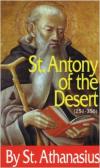Temptations of St. Antony in Art: Early Modern & Modern Painting

Antony's Life
In St. Antony the Great (or Antony of the Desert), the polemicist
bishop St. Athanasius
(296-373) identified the
archetypal hermit. Athanasius's Life
of St.
Antony is a modest tract that became a hagiographical
masterpiece of
eremitic personality, values, and virtues. The stirring biography was
bound to find artisitic and expressive outlets over time.
From the outset of his little work, Athanasius vividly but methodically describes the earnestness of the monk's faith and determination, pitted against the temptations of Satan, who first confronts the monk's aspirations with gentle plaudits, then -- after Antony has moved afar to pursue an eremitic life in tombs -- assaults him physically. When Antony next moves to an abandoned desert fort, the combat between hermit and demons continues, but now more predictably, almost didactically, and the hagiographical point of sainthood is establish.
Antony, the ideal hermit of the desert, "spent nearly twenty years in this solitary religious life, neither going out nor being seen regularly by any," Athanasius tells us. Antony emerges as an articulate teacher who works successfully with prisoners and miners, attracts crowds by his visions and miracles, and spends his last years combating the Melitien, Manichean, and Arian heresies (like Athanasius himself).
Antony's success against the regular attacks of demons is guaranteed by his regimen of faith, prayer, fasting, vigils, and austerities. When he slept it was on a rush mat on the floor of his cave or dwelling. When he ate he took one daily meal, after sunset, fasting every other day or so. His spiritual success he attributes to beginning each day with a basic resolution, not trusting to the length of time in which he had endured or the strength of skills acquired.
Antony's Temptations
Athanasius shows us the initial plaudits of the devil confronting
Antony: dissuading Antony's resolution by itemizing the losses of the
world: of property, family and kindred
relations, money, fame, the pleasures of the table, the relaxations
of life against the hardness of virtue.
The next stage of dissuasion is in presenting evil thoughts, in the appearance of a woman at night to seduce him and of a black boy during the day to flatter him piteously. After dismissing these and taking up the hermit life in tombs the demons come to physically scourge him, with "pain so severe than blows from men could not have caused such agony." When Antony nevertheless recovers from this physical assault, the demons fill his tiny dwelling with monstrous animals: lions, bears, wolves, serpents, all making frightful roars and noises.
Antony learns to mock the demons in their powerlessness, but only because he has fortified himself spiritually, Athanasius tells us, further healed by heavenly visions and dialog. Thus when Antony is ready to move into still deeper desert solitude, the successive temptations barely stir him: from a silver disc and gold, representing money and power, to regular battles with demons in the old fort, including the aforementioned menace of wild animals, even a centaur.
Not unexpectedly, the temptations of St. Antony are the subject of many painters in the Western world. During the Italian Renaissance and Baroque, and during the Netherlandish Golden Age, painters adhered to the religious intentions of the earliest hagiography, depicting the temptations and the stalwart if nervous defense of the hermit.
The earliest illustrations of the theme are in medieval books and missals. In formal art, the earliest work is credited to German engraver Martin Schongauer (1435-91), imitated in a painting by the then 12-year old Michaelangelo (1475-1564). Among painters in the Northern schools (German, Dutch, Flemish) were Matthias Grunewald (1470-1528), Heironymus Bosch 1450-1516), and the school of Pieter Bruegel (1525-1569).
But with modern times, painters of the romantic and decadent schools
predominate. The
temptations theme is an opportunity for depicting the salacious and
blasphemous. In his
essay On Ugliness,
Umberto Eco has rightly emphasized the reversal of roles in the
depiction of Antony's temptations highlighted after the appearance of
Flaubert's The Temptations of St.
Antony,
written in 1874. In deliberate contrast to the pious
combatant Antony versus the ugliness of the devil and his plaudits,
Flaubert presented the simpering weakling versus the clever and adept
devil and his chief device of erotic temptation, thus expressing with
sadistic prose and art the era's hatred for any sort of perceived
moralism.
The late-19th and early
20th-century modern school of painters of the temptations theme is
dominated by
the decadents (Fantin-Latour, Felicien-Rops, Lovis Corinth,
Dollman). Only Millet tries to salvage a sympathy for Antony. A
transition is seen, however, in the surrealists (Ernst, Carrington,
Dali, Rivera)
echoing the early modern depiction of the grotesque. The overtly
religious Szyk (Jewish) and Leastar (Catholic) are symbolists,
remarkably similar to one another in theme and composition.
A comprehensive history of the temptation theme, from medieval
sources to the modern, with many more representative expressions, waits
to be assembled. But the theme will always remain a regular source of
provocation for hostile-minded artists, painters, writers, and
film-makers, who will probably always dominate the genre.
Some representative paintings are in two parts of a Hermitary
gallery:
http://www.hermitary.com/features/art/antony-temptations/1/
¶
BIBLIOGRAPHICAL REFERENCES
Standard translations of Athanasius's Life of St. Antony include: The Life of Antony, translated by Tim Vivian; Kalamazoo, MI: Cistercian Publications, 2003 and The Life of Antony, translated by Robert C. Gregg; San Francisco: HarperSanFrancisco, 2006. Old standards are The Life of Saint Antony, translated by Robert T. Meyer; Westminster, MD: Newman Press, 1950 and St. Antony the Hermit, translated by J.B. McLaughlin; New York: Benziger, 1924 and later reprints.
